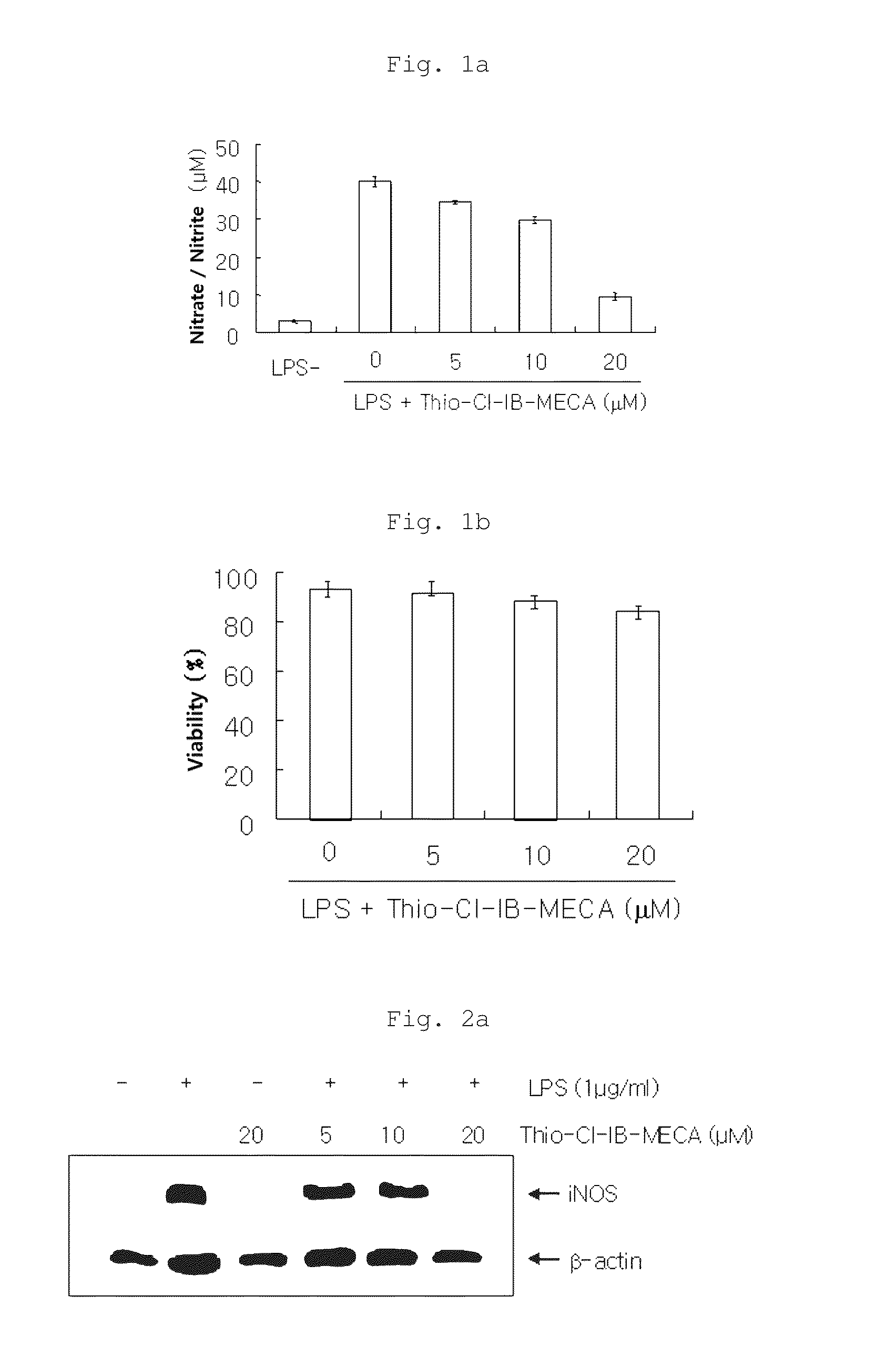Method for treating prostate cancer by use of pharmaceutical composition containing a3 adenosine receptor agonist
a technology of adenosine receptor and a pharmaceutical composition, which is applied in the direction of drug compositions, immunodeficiency disorders, biocide, etc., can solve the problems of limited use of such asub>3/sub>ar agonists, side effects such as cytotoxicity, and difficult development of cancer treatment agents, and achieve excellent anti-inflammatory effects and inhibitory effects, and effective use of prostate cancer
- Summary
- Abstract
- Description
- Claims
- Application Information
AI Technical Summary
Benefits of technology
Problems solved by technology
Method used
Image
Examples
example 1
Examination of NO Production Inhibitory Activity (iNOS Assay)
[0064]A test was carried out to examine the inhibitory activity of the inhibitory activity of the inventive composition on the enzyme iNOS (inducible nitric oxide synthase) whose expression increases when inflammatory reactions and traumas exist.
[0065]Specifically, RAW 264.7 cells (5×105 cells / ml) were added to a 24-well plate with 10% FBS-containing DMEM medium in an amount of 1 ml per well and cultured for 24 hours. After 24 hours, the adherent cells were washed with PBS (phosphate-buffered saline) and then treated with 10% FBS-DMEM medium (phenol red-free) and the inventive composition (containing each of 5, 10 and 20 μM of thio-Cl-IB-MECA). After 30 minutes, 1 μg / ml of LPS was added to the cells which were then cultured in a 5% CO2 incubator at 37° C. for 20 hours (test groups). As a blank, RAW cells cultured without addition of LPS and the inventive composition were used, and as a control group, RAW cells cultured wit...
example 2
Evaluation of Inhibitory Effects on the Expression of iNOS Protein and Gene
[0070]The effects of the inventive composition on the expression of iNOS protein and mRNA were examined by Western blot analysis and RT-PCR. Specifically, RAW 264.7 cells were diluted with 10% FBS-containing medium to a density of 1×106 cells per 100 mm culture dish and cultured under the conditions of 37° C. and 5% CO2 for 24 hours, followed by washing twice with PBS. The cells were pretreated with each of 20 μM (the highest concentration showing no cytotoxicity), 10 μM and 5 μM of thio-Cl-IB-MECA in 10% FBS-containing medium, and inflammatory reactions in the cells were induced by LPS (1 μg / ml), followed by culture for 18 hours. The non-adherent cells and adherent cells in the cell medium were collected and washed twice with PBS, and then the cells were suspended in lysis buffer and heated at 100° C. for 5 minutes. The cells were cooled and then stored at 20° C. The cells were thawed at 37° C. immediately b...
example 3
Effects on the Expression of TNF-α
[0076]TNF-α is a cytokine whose expression increases in cells stimulated by LPS, and it influences the expression of IL-1β and the progression of inflammatory reactions. Thus, the effect of the inventive composition on the expression of TNF-α was examined. Specifically, RAW 264.7 cells were pretreated with each of 20, 10 and 5 μM of the inventive composition (thio-Cl-IB-MECA) and treated with LPS (1 μg / ml) to induce inflammatory reactions. Then, the cells were incubated for 6 hours, after which the supernatant was taken and the amount of TNF-α secreted into the supernatant was measured using an ELISA (electrophoresis mobility shift assay) kit. The results of the measurement are shown in FIG. 3a.
[0077]In addition, in order to examine whether TNF-α is expressed at the gene level, the effect of the inventive composition on the expression of TNF-α mRNA was also tested using the RT-PCR method. The results of the test are shown in FIG. 3b.
[0078]As shown...
PUM
| Property | Measurement | Unit |
|---|---|---|
| concentration | aaaaa | aaaaa |
| concentration | aaaaa | aaaaa |
| weight | aaaaa | aaaaa |
Abstract
Description
Claims
Application Information
 Login to View More
Login to View More - R&D
- Intellectual Property
- Life Sciences
- Materials
- Tech Scout
- Unparalleled Data Quality
- Higher Quality Content
- 60% Fewer Hallucinations
Browse by: Latest US Patents, China's latest patents, Technical Efficacy Thesaurus, Application Domain, Technology Topic, Popular Technical Reports.
© 2025 PatSnap. All rights reserved.Legal|Privacy policy|Modern Slavery Act Transparency Statement|Sitemap|About US| Contact US: help@patsnap.com



